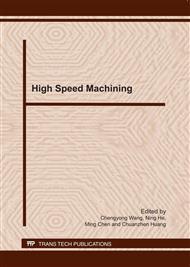p.535
p.542
p.549
p.555
p.561
p.566
p.572
p.578
p.584
Vibration Analysis on Ball End Milling Hardened Mould Assembled with Different Hardness Materials
Abstract:
Analytical and experimental identifications on the characteristics of the acceleration signal in high speed milling (HSM) process using ball end mill were studied. Three parts of harden steel with different hardness were assembled together, as opposed to the single harden steel in general HSM process. Dynamic model of ball end milling was established, tests with new and worn cutter were carried out respectively. Time domain analysis on the acceleration signal showed that the amplitude varies with the hardness through the whole cutting path. Furthermore, frequency domain analysis using fast Fourier transform (FFT) technique shows that the spectrum of the vibration signal using new cutter contain the tool spindle rotation speed as fundamental frequency and its harmonics. On the other hand, the spectrum of vibration signal under tool wear state contain other frequencies in addition to the fundamental frequency and harmonics, and this feature of spectrum can be used to monitor the state of the cutter during HSM.
Info:
Periodical:
Pages:
561-565
Citation:
Online since:
March 2011
Authors:
Price:
Сopyright:
© 2011 Trans Tech Publications Ltd. All Rights Reserved
Share:
Citation:


